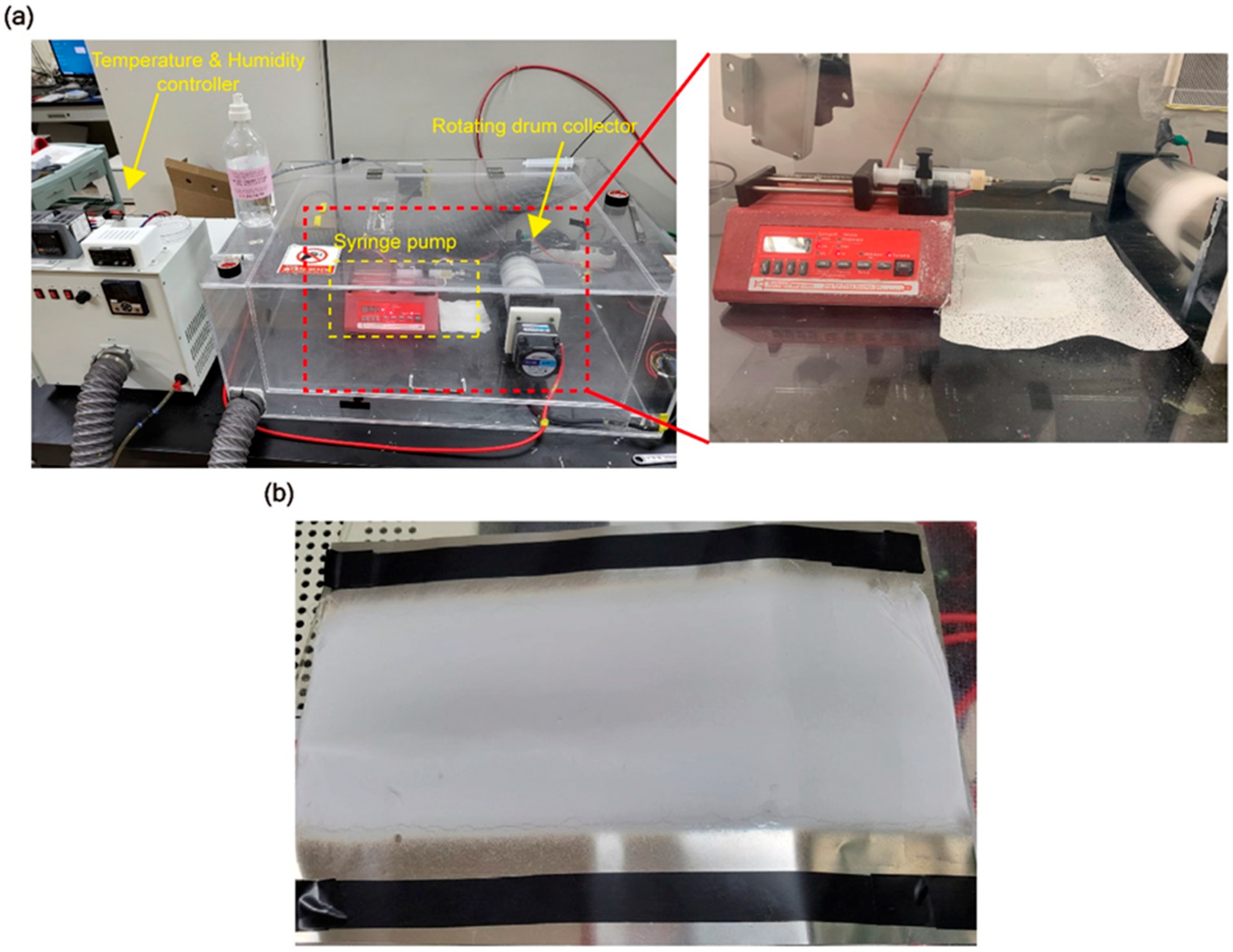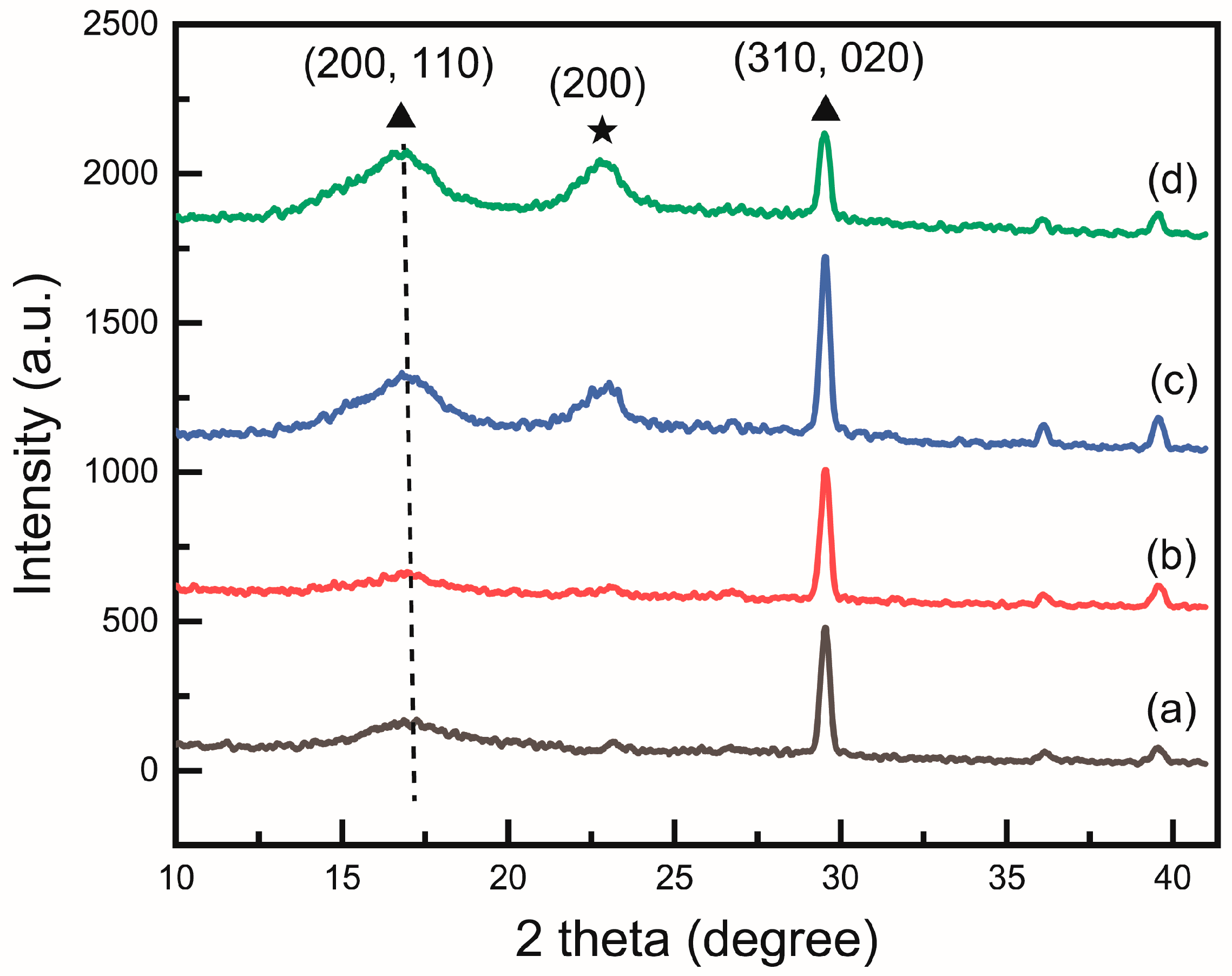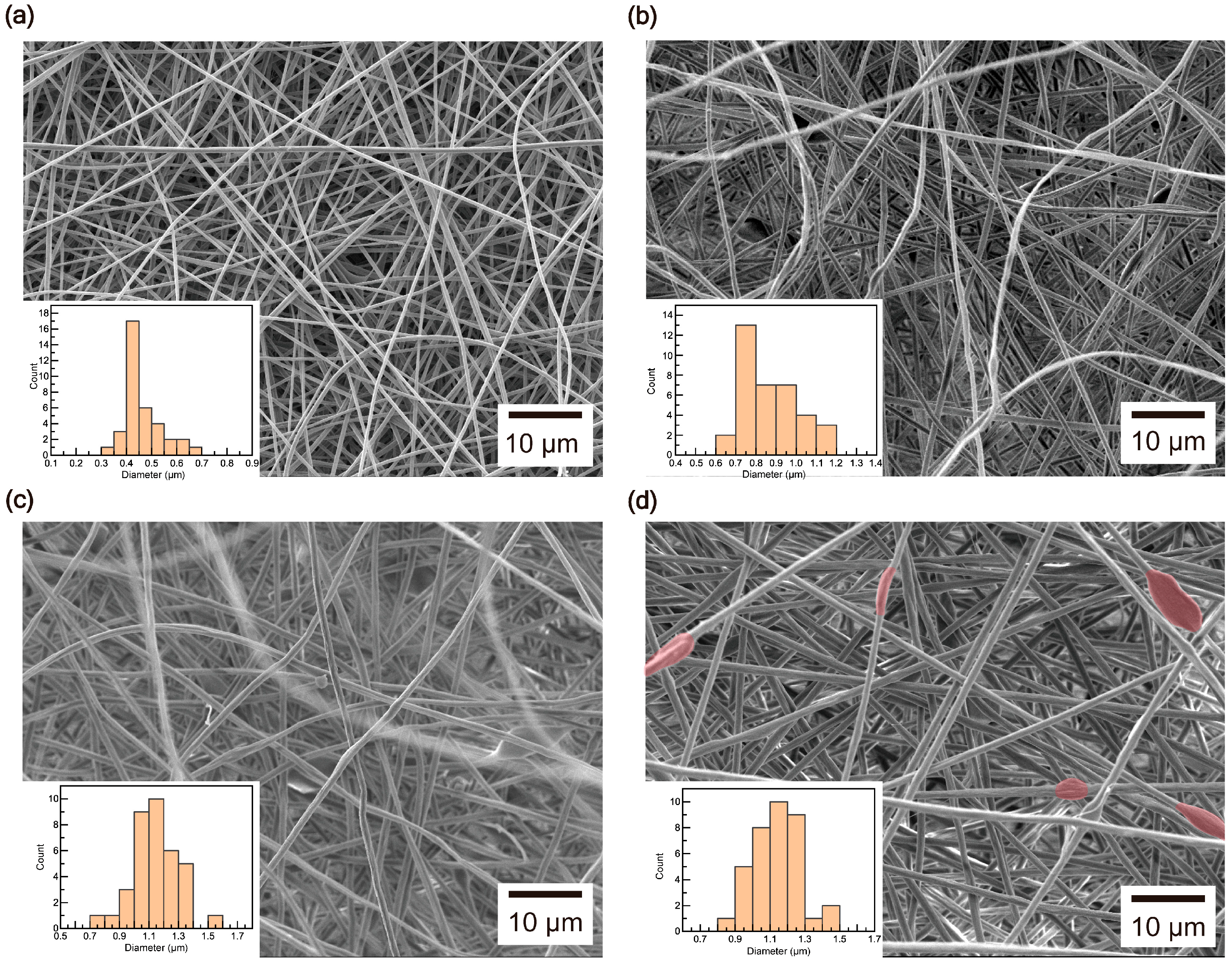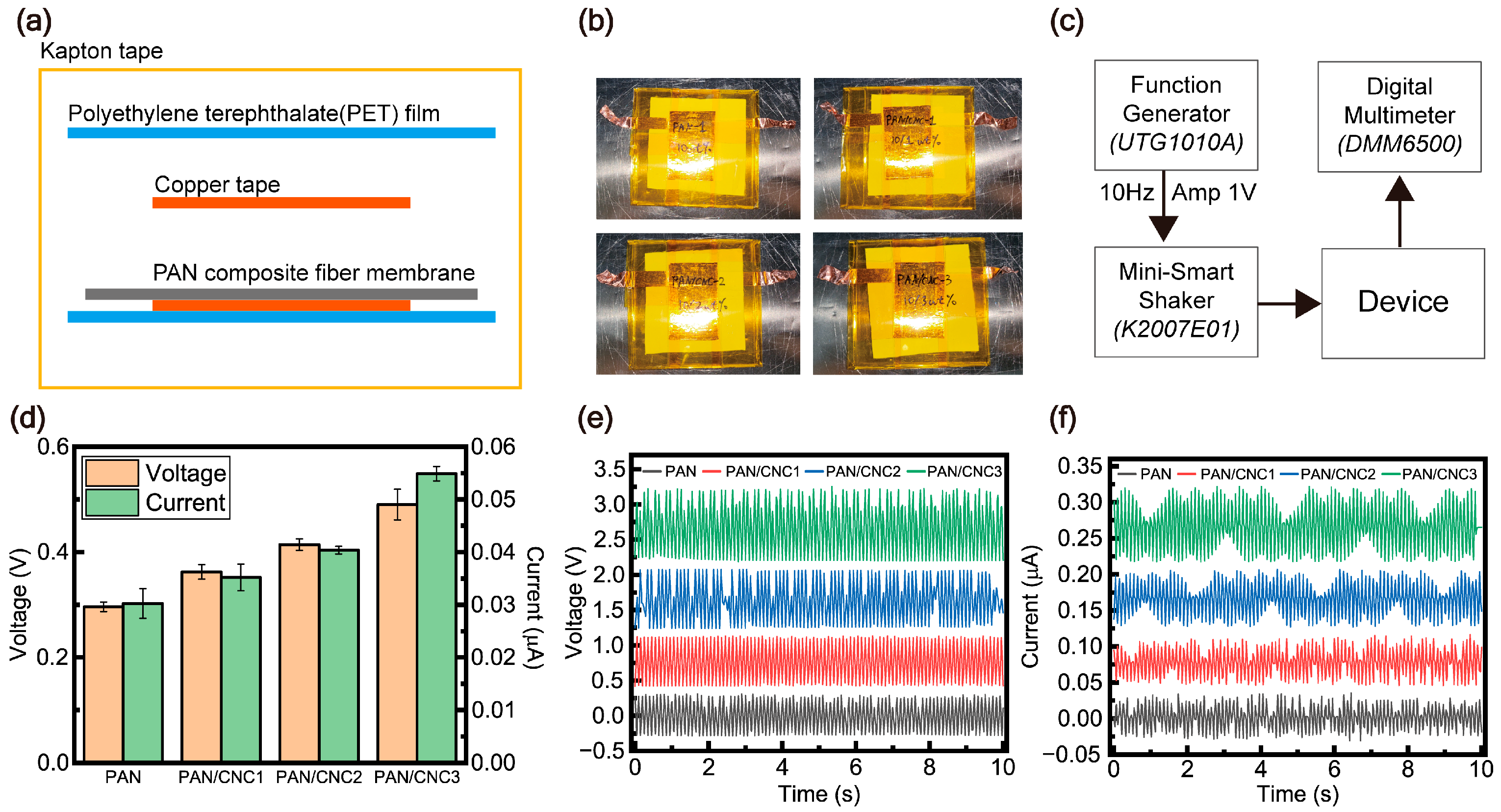Enhancing Piezoelectricity of Polyacrylonitrile–Cellulose Composite Nanofibers via Zigzag Conformation
Abstract
1. Introduction
2. Materials and Methods
2.1. Materials
2.2. Synthesis of Composite Material Solution
2.3. Eletrospinning
2.4. Fabrication of Piezoelectric Device
2.5. Characterization
3. Results and Discussion
4. Conclusions
Author Contributions
Funding
Institutional Review Board Statement
Data Availability Statement
Conflicts of Interest
References
- Farinholt, K.M.; Pedrazas, N.A.; Schluneker, D.M.; Burt, D.W.; Farrar, C.R. An energy harvesting comparison of piezoelectric and ionically conductive polymers. J. Intell. Mater. Syst. Struct. 2009, 20, 633–642. [Google Scholar] [CrossRef]
- Sappati, K.K.; Bhadra, S. Piezoelectric Polymer and Paper Substrates: A Review. Sensors 2018, 18, 3605. [Google Scholar] [CrossRef] [PubMed]
- Hussain, A.; Jabeen, N.; Tabassum, A.; Ali, J. 3D Printed Conducting Polymers; CRC Press: Boca Raton, FL, USA, 2024; pp. 179–195. [Google Scholar] [CrossRef]
- Mishra, S.; Unnikrishnan, L.; Nayak, S.K.; Mohanty, S. Advances in Piezoelectric Polymer Composites for Energy Harvesting Applications: A Systematic Review. Macromol. Mater. Eng. 2019, 304, 1800463. [Google Scholar] [CrossRef]
- Kim, H.; Torres, F.; Wu, Y.; Villagran, D.; Lin, Y.; Tseng, T. Integrated 3D printing and corona poling process of PVDF piezoelectric films for pressure sensor application. Smart Mater. Struct. 2017, 26, 085027. [Google Scholar] [CrossRef]
- Mirjalali, S.; Varposhti, A.M.; Abrishami, S.; Bagherzadeh, R.; Asadnia, M.; Huang, S.; Peng, S.; Wang, C.H.; Wu, S. A Review on Wearable Electrospun Polymeric Piezoelectric Sensors and Energy Harvesters. Macromol. Mater. Eng. 2023, 308, 2200442. [Google Scholar] [CrossRef]
- Zhi, C.; Shi, S.; Fei, B.; Huang, H.; Hu, J. Recent Progress of Wearable Piezoelectric Pressure Sensors Based on Nanofibers, Yarns, and Their Fabrics via Electrospinning. Adv. Mater. Technol. 2023, 8, 2201161. [Google Scholar] [CrossRef]
- Dong, K.; Peng, X.; Wang, Z.L. Fiber/Fabric-Based Piezoelectric and Triboelectric Nanogenerators for Flexible/Stretchable and Wearable Electronics and Artificial Intelligence. Adv. Mater. 2020, 32, 1902549. [Google Scholar] [CrossRef]
- Kweon, O.Y.; Lee, S.J.; Oh, J.H. Wearable high-performance pressure sensors based on three-dimensional electrospun conductive nanofibers. NPG Asia Mater. 2018, 10, 540–551. [Google Scholar] [CrossRef]
- Heo, J.S.; Eom, J.; Kim, Y.H.; Park, S.K. Recent Progress of Textile-Based Wearable Electronics: A Comprehensive Review of Materials, Devices, and Applications. Small 2018, 14, 1703034. [Google Scholar] [CrossRef]
- Wang, F.; Dou, H.; You, C.; Yang, J.; Fan, W. Enhancement of Piezoelectric Properties of Flexible Nanofibrous Membranes by Hierarchical Structures and Nanoparticles. Polymers 2022, 14, 4268. [Google Scholar] [CrossRef]
- Wang, W.; Zheng, Y.; Jin, X.; Sun, Y.; Lu, B.; Wang, H.; Fang, J.; Shao, H.; Lin, T. Unexpectedly high piezoelectricity of electrospun polyacrylonitrile nanofiber membranes. Nano Energy 2019, 56, 588–594. [Google Scholar] [CrossRef]
- Tao, J.; Wang, Y.; Zheng, X.; Zhao, C.; Jin, X.; Wang, W.; Lin, T. A review: Polyacrylonitrile as high-performance piezoelectric materials. Nano Energy 2023, 118, 108987. [Google Scholar] [CrossRef]
- Shi, Q.; Xue, R.; Huang, Y.; He, S.; Wu, Y.; Liang, Y. A Flexible Multifunctional PAN Piezoelectric Fiber with Hydrophobicity, Energy Storage, and Fluorescence. Polymers 2022, 14, 4573. [Google Scholar] [CrossRef] [PubMed]
- Montorsi, M.; Zavagna, L.; Scarpelli, L.; Azimi, B.; Capaccioli, S.; Danti, S.; Labardi, M. Piezoelectric Yield of Single Electrospun Poly(acrylonitrile) Ultrafine Fibers Studied by Piezoresponse Force Microscopy and Numerical Simulations. Polymers 2024, 16, 1305. [Google Scholar] [CrossRef]
- Grobelny, J.; Sokól, M.; Turska, E. A study of conformation, configuration and phase structure of polyacrylonitrile and their mutual dependence by means of WAXS and 1H BL-n.m.r. Polymer 1984, 25, 1415–1418. [Google Scholar] [CrossRef]
- Rizzo, P.; Auriemma, F.; Guerra, G.; Petraccone, V.; Corradini, P. Conformational Disorder in the Pseudohexagonal Form of Atactic Polyacrylonitrile. Macromolecules 1996, 29, 8852–8861. [Google Scholar] [CrossRef]
- Hobson, R.J.; Windle, A.H. Crystalline structure of atactic polyacrylonitrile. Macromolecules 1993, 26, 6903–6907. [Google Scholar] [CrossRef]
- Chang, H.; Chien, A.T.; Liu, H.C.; Wang, P.H.; Newcomb, B.A.; Kumar, S. Gel Spinning of Polyacrylonitrile/Cellulose Nanocrystal Composite Fibers. ACS Biomater. Sci. Eng. 2015, 1, 610–616. [Google Scholar] [CrossRef]
- Chung, D.D.L. Continuous carbon fiber polymer-matrix composites and their joints, studied by electrical measurements. Polym. Compos. 2001, 22, 250–270. [Google Scholar] [CrossRef]
- Qu, Y.; Zhang, Y.; Qu, J. Micro-Driving behavior of carbon-fiber-reinforced epoxy resin for standing-wave ultrasonic motor. Polym. Compos. 2016, 37, 2152–2159. [Google Scholar] [CrossRef]
- Zhang, Z.; Li, Z.; Zhang, M.; Hao, H.; Yan, S. Resistance-type strain sensor based on carbon nanofiber/polypyrrole composite membrane with high sensitivity. Polym. Compos. 2024, 45, 8876–8888. [Google Scholar] [CrossRef]
- George, J.; Sabapathi, S. Cellulose nanocrystals: Synthesis, functional properties, and applications. Nanotechnol. Sci. Appl. 2015, 8, 45–54. [Google Scholar] [CrossRef] [PubMed]
- Awal, A.; Sain, M. Cellulose–Polymer Based Green Composite Fibers by Electrospinning. J. Polym. Environ. 2012, 20, 690–697. [Google Scholar] [CrossRef]
- Peres, B.U.; Manso, A.P.; Carvalho, L.D.; Ko, F.; Troczynski, T.; Vidotti, H.A.; Carvalho, R.M. Experimental composites of polyacrilonitrile-electrospun nanofibers containing nanocrystal cellulose. Dent. Mater. 2019, 35, e286–e297. [Google Scholar] [CrossRef]
- Sawai, D.; Yamane, A.; Kameda, T.; Kanamoto, T.; Ito, M.; Yamazaki, H.; Hisatani, K. Uniaxial Drawing of Isotactic Poly(acrylonitrile): Development of Oriented Structure and Tensile Properties. Macromolecules 1999, 32, 5622–5630. [Google Scholar] [CrossRef]
- Chae, H.G.; Minus, M.L.; Kumar, S. Oriented and exfoliated single wall carbon nanotubes in polyacrylonitrile. Polymer 2006, 47, 3494–3504. [Google Scholar] [CrossRef]
- Boerio, F.J.; Koenig, J.L. Vibrational Spectroscopy of Polymers. J. Macromol. Sci. Rev. Macromol. Chem. 2006, 7, 209–249. [Google Scholar] [CrossRef]
- Wangxi, Z.; Jie, L.; Gang, W. Evolution of structure and properties of PAN precursors during their conversion to carbon fibers. Carbon 2003, 41, 2805–2812. [Google Scholar] [CrossRef]
- Chen, D.; Wang, X.; Liang, J.; Zhang, Z.; Chen, W. A Novel Electrospinning Polyacrylonitrile Separator with Dip-Coating of Zeolite and Phenoxy Resin for Li-ion Batteries. Membranes 2021, 11, 267. [Google Scholar] [CrossRef]
- Radhi, M.M.; Haider, A.J.; Jameel, Z.N.; Tee, T.W.; Rahman, M.Z.; Kassim, A.B. Synthesis and Characterization of Grafted Acrylonitrile on Polystyrene modified with Carbon nanotubes using Gamma-irradiation. Res. J. Chem. Sci. 2012, 2, 1–7. [Google Scholar]
- Zhou, C.; Chu, R.; Wu, R.; Wu, Q. Electrospun Polyethylene Oxide/Cellulose Nanocrystal Composite Nanofibrous Mats with Homogeneous and Heterogeneous Microstructures. Biomacromolecules 2011, 12, 2617–2625. [Google Scholar] [CrossRef]






| PAN (wt%) | CNC (wt%) | Voltage (V) | Current (µA) | Zigzag Conformation (%) |
|---|---|---|---|---|
| 10 | 0 | 0.296 ± 0.008 | 0.03 ± 0.002 | 53.51 |
| 1 | 0.362 ± 0.013 | 0.035 ± 0.002 | 63.59 | |
| 2 | 0.414 ± 0.01 | 0.04 ± 0.0007 | 68.85 | |
| 3 | 0.49 ± 0.028 | 0.054 ± 0.001 | 74.27 |
Disclaimer/Publisher’s Note: The statements, opinions and data contained in all publications are solely those of the individual author(s) and contributor(s) and not of MDPI and/or the editor(s). MDPI and/or the editor(s) disclaim responsibility for any injury to people or property resulting from any ideas, methods, instructions or products referred to in the content. |
© 2025 by the authors. Licensee MDPI, Basel, Switzerland. This article is an open access article distributed under the terms and conditions of the Creative Commons Attribution (CC BY) license (https://creativecommons.org/licenses/by/4.0/).
Share and Cite
Lim, J.Y.; Kwak, W.S.; Park, M.; Kim, Y.S. Enhancing Piezoelectricity of Polyacrylonitrile–Cellulose Composite Nanofibers via Zigzag Conformation. Polymers 2025, 17, 465. https://doi.org/10.3390/polym17040465
Lim JY, Kwak WS, Park M, Kim YS. Enhancing Piezoelectricity of Polyacrylonitrile–Cellulose Composite Nanofibers via Zigzag Conformation. Polymers. 2025; 17(4):465. https://doi.org/10.3390/polym17040465
Chicago/Turabian StyleLim, Joong Yeon, Won Suk Kwak, Minwook Park, and Young Seong Kim. 2025. "Enhancing Piezoelectricity of Polyacrylonitrile–Cellulose Composite Nanofibers via Zigzag Conformation" Polymers 17, no. 4: 465. https://doi.org/10.3390/polym17040465
APA StyleLim, J. Y., Kwak, W. S., Park, M., & Kim, Y. S. (2025). Enhancing Piezoelectricity of Polyacrylonitrile–Cellulose Composite Nanofibers via Zigzag Conformation. Polymers, 17(4), 465. https://doi.org/10.3390/polym17040465






